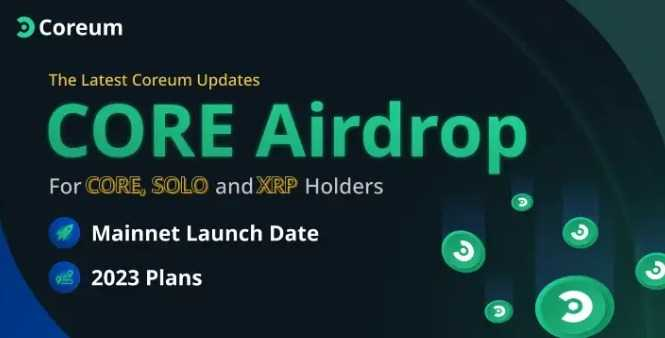In this blog post, Coreum developers reveal the mainnet launch date of Coreum Layer-1 Blockchain and details on a new round of community airdrops for the CORE, SOLO and XRP holders.
Since its announcement in Dec 2021, Coreum Blockchain has gained tremendous global attention by introducing a new standard for enterprise use cases, such as ISO20022 compliance and Smart Tokens. Learn more about Coreum technologies here.
Coreum’s open-source project is 100% community-owned and is built by developers with a passion for making a more advanced, secure and fast blockchain for any size of the enterprise.
Mainnet Launch, Staking, Partnerships and VC Fundraising Round
Mainnet Launch Date: The highly anticipated mainnet launch of the Coreum Blockchain will take place on the 24th of March 2023 at around 04:00 AM UTC.
Staking: Once the mainnet is live, participants will have a unique opportunity to start staking their CORE tokens on the Coreum Blockchain. It’s forecasted the early stakers benefit from APRs as high as 40% initially while the total supply is moving from XRPL to Coreum blockchain.
Partnerships and Exchange Listings: The Growth and Partnership teams at Coreum have been working hard behind the scenes to bring more value to the Coreum ecosystem. Right after the mainnet launch, we will announce many exciting partnerships like various institutional validators, wallet integrations and Tier-1 exchange listings.
VC Fundraising: Since its inception, the Core team’s principle was to develop an open-source technology that is 100% community based without public token sale (IEO, ICO or IDO), which has traditionally been a common practice among most blockchain projects. Coreum will launch its first fundraising round in Q1 2023 for reputable VCs and Institutional accredited investors.
CORE and xCORE Airdrops
Coreum has been a 100% community-based project and will always remain the same. Community and technology are the main backbones of any blockchain project, and the success and future adoption of its technology depend directly on both factors. Within the past 18 months, we’ve been working around the clock on the research and development of Coreum technology. As we’re getting closer to the mainnet launch, it’s a suitable time to expand the Coreum community, increase its reach within the crypto space and make the ecosystem truly decentralized by airdropping the majority of the supply to the community.
To engage more crypto communities to participate in the Coreum ecosystem, the Core Team has decided to unlock and conduct an airdrop of 100,000,000 CORE tokens to the CORE holders and 50M xCORE token (Option Tokens with a Strike Option Price of $10) to both SOLO and XRP holders.
What’s the Airdrop Ratio of CORE and xCORE?
A total of 100,000,000 CORE tokens will be distributed to those accounts that hold CORE, and a total of 50,000,000 xCORE tokens will be distributed to the wallets that hold SOLO and/or XRP at the time of the snapshot.
The following ratio will be applied to the distribution:
CORE holders*: 100% of the total CORE Airdrop amount (100M CORE tokens)
*Please note that a TrustLine to the Coreum Gateway must be in place for the account to be eligible for the airdrop.
XRP holders*: 50% of the total xCORE airdrop amount (25M xCORE tokens)
SOLO holders*: 50% of the total xCORE airdrop amount (25M xCORE tokens)
*Please note that a TrustLine to the xCORE Gateway must be in place for the account to be eligible for the airdrop.

Example For CORE Airdrop Ratio Calculation: Let’s assume the final amount of CORE, which is qualified for the CORE airdrop at the time of the snapshot, is as follows:
CORE: 50,000,000
Then the number of CORE Airdrops for the holders of the CORE will be calculated and deposited as below:
CORE Holders Ratio:
100,000,000 ÷ 50,000,000 = 2 CORE* per each CORE Holding
(Total CORE Airdrop Amount) ÷ (Total Participation amount) = CORE Airdrop Ratio
*The final ratio calculation of the CORE airdrop is subject to the total number of CORE holdings participating in the airdrop. It will be calculated and announced officially post-snapshot date.
Example For xCORE Airdrop Ratio Calculation: Let’s assume the final amount of SOLO and/or XRP, which are qualified for the xCORE airdrop at the time of the snapshot, are as follows:
SOLO: 100,000,000
XRP: 1,000,000,000
Then the number of CORE Airdrops for the holders of the CORE will be calculated and deposited as below:
SOLO Holders Ratio:
(50,000,000 ÷ 2) ÷ 100,000,000 = 0.25 xCORE* per each SOLO Holding
(50% of Total xCORE Airdrop Amount) ÷ (Total Participation amount) = xCORE Airdrop Ratio
XRP Holders Ratio:
(50,000,000 ÷ 2) ÷ 1,000,000,000 = 0.025 xCORE* per each XRP Holding
(50% of Total xCORE Airdrop Amount) ÷ (Total Participation amount) = xCORE Airdrop Ratio
*The final ratio calculation of the xCORE airdrop is subject to the total number of XRP and/or SOLO holdings participating in the airdrop. It will be calculated and announced officially post-snapshot date.
What’s xCORE? How does the Redemption work?
To further incentivize the community and avoid immediate pressure on the CORE market after the airdrop distribution, the Core team is issuing 50M xCORE tokens (at a value of $500M USD) to be airdropped exclusively to the SOLO and XRP communities.
xCORE is an Option Token that can be exchanged for CORE tokens if the CORE price reaches and stays above $10.00 for 240 consecutive hours (10 days) or expires on March 24th, 2025, 04:00 AM UTC.
After its expiry, regardless of the price, holders of xCORE are eligible to exchange 1:1* to CORE tokens via a smart contract on the Coreum Blockchain.
*1 xCORE is always fully backed by 1 CORE and held in a smart contract on the Coreum Blockchain until redemption takes place. xCORE is interoperable with XRPL and Coreum Blockchain and can be bridged for redemption.
In a nutshell, if you hold XRP or SOLO at the time of the snapshot, you will receive* xCORE tokens, which can be exchanged for CORE tokens, given the price of CORE goes above $10. If it does not, you will receive 1 CORE regardless of the price after 2 years.
*To receive the xCORE token, you must issue a TrustLine to the xCORE gateway mentioned in this article. Scroll down to the end of this article and learn how to set up your Trustline.
Type: Token Option
Symbol: XCORE
Strike Price: $10 USD — Remains above the strike price for 240 hours (10 days)
Expiry: March 24th, 2025 04:00 AM UTC
Backed by: CORE (1 XCORE = 1 CORE)
XRPL Issuing Address: r3dVizzUAS3U29WKaaSALqkieytA2LCoRe
Coreum Smart Contract Redemption Address: TBA after mainnet launch
When will the Snapshot be taken?
Snapshot Date/Time: March 24th, 2023, 04:00 AM UTC.
When will the CORE and xCORE Airdrops be Distributed?
CORE airdrop distribution to the CORE holders will take place in 4 equal instalments with 60 days buffer time in-betweens, and the xCORE will be distributed in one instalment to the XRP and/or SOLO holders as follows:
CORE Distribution (For CORE Holders)
Distribution 1: 1st Apr 2023
Distribution 2: 1st Jun 2023
Distribution 3: 1st Aug 2023
Distribution 4: 1st Nov 2023
xCORE Distribution (For XRP and/or SOLO Holders)
The xCORE airdrop distribution to the SOLO and XRP holders will take place on 15th May 2023.
Why is the SOLO community included in this Airdrop?
The Coreum idea was developed by the Sologenic development foundation and backed by the SOLO community. It’s time to make the bond between both SOLO and CORE communities even stronger than before.
The Sologenic team never stops!
We continue to develop new use cases and innovative ideas within the Sologenic ecosystem on both XRP Ledger and Coreum Blockchain. The most compelling use case is the tokenized assets trading platform which is planned to go live as a pilot program in specific jurisdictions in 2023.
Sologenic will also integrate with the Coreum networks so users can hold and trade fungible and non-fungible assets on both Coreum and XRP Ledger. In Q1 2023, SOLO Cards and Sologenic IDO launchpad will also go live.
Why is the XRP community included in this Airdrop?
Coreum was built out of a necessity by the Sologenic Tokenization Platform, and the XRPL has been a key to this journey. The XRP Ledger inspired many aspects of the Coreum Blockchain, and we would like to keep the two blockchains side-by-side that complete one another and remain interoperable.
For this reason, the first asset other than IBC-based assets that will be bridged to the Coreum Blockchain is the XRP and other tokenized assets on the XRPL.
This interoperability allows these assets to fully utilize the power of the Coreum Blockchain and create more use cases by using Smart Contracts and Smart Tokens. In addition, by design, these assets will flow into the Cosmos-based chains through IBC.
This will unlock many new opportunities for XRP, such as DeFi and innovative smart contracts-based d’Apps.
What wallets will be excluded?
All the wallets belonging to the foundation and teams at Coreum and Sologenic will be excluded from the airdrop, and any exchange or custodial company’s wallets will not release an official announcement to support the airdrop to their users. The team at Coreum would like to ensure the airdrop will go directly to the communities.
What’s next for COREUM?
The Core development team is constantly working on adding more features to the Coreum blockchain as well as monitoring and securing the network. After the mainnet launch, the team will focus on expanding the functionalities of Smart Tokens by adding more native features and support for different use cases. In the second development phase, the Core team will start developing the built-in full order-book DEX on the Coruem Blockchain. This allows all issued smart tokens on the chain to be seamlessly traded.
In addition, Coreum is anticipated to become the “Hub” for blockchain developers, allowing tokens to be issued on Coreum and flow through the Inter-Blockchain Communication Protocol (IBC) supported chains.
How to set up Trustlines?
CORE Holders
If you hold your CORE tokens on decentralized wallets like SOLO DEX and XUMM and you wish to participate in the CORE Airdrop, you can learn how to establish a trustline with Coreum gateway on the XRP Ledger here.
If you hold your CORE holdings on a centralized exchange, you need to contact your exchange to ensure they will support this Airdrop.
XRP and/or SOLO Holders
If you hold your SOLO and/or XRP tokens on decentralized wallets like SOLO DEX and XUMM and you wish to participate in the xCORE Airdrop, you should establish a trustline with xCORE gateway on the XRP Ledger. You can watch this example video here and change the parameters with the followings specs:
xCORE Gateway (Issuer): r3dVizzUAS3U29WKaaSALqkieytA2LCoRe
xCORE Currency Code: 58434F5245000000000000000000000000000000
Limit: 50,000,000
If you hold your XRP and/or SOLO holdings on a centralized exchange, you need to contact your exchange to make sure they will support this Airdrop for the XRP and/or SOLO holders on their exchange.




























